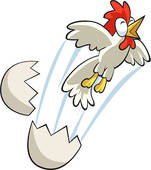12 Answers
The evolution of eggs predates the evolution of chickens.
| 13 years ago. Rating: 12 | |
Here it is:
icb.oxfordjournals.org/content/20/2/351.abstract
Abstract
Evolution of the avian egg from the naked amniotic egg of ancestral reptiles probably was the outcome of intense predation by soil invertebrates and microbes on a highly integrated and coadapted complex of characters. The calcareous shell which from its inception afforded a measure of protection to eggs against attacks by soil organisms became progressively thicker and more complex in the face of continuing selection for antipredator devices. However, increases in thickness and complexity of eggshells led to simultaneous reductions in the amount of liquid water that could be absorbed by incubating eggs from the substrate. Because embryos initially were dependent upon uptake of substantial quantities of water from the environment to satisfy their needs for this solvent, adaptive increases in thickness of the eggshell required coupled increases in the amount of water contained by eggs at oviposition, thereby reducing the degree of dependence of embryos upon external sources of water for successful completion of development. The rigid-shelled eggs resulting from this evolutionary sequence absorbed little (if any) liquid water during incubation, and the eggs contained sufficient water at oviposition to sustain embryos to hatching. Such eggs were functionally cleidoic and had attained an avian level of organization.
icb.oxfordjournals.org/content/20/2/351.abstract
Abstract
Evolution of the avian egg from the naked amniotic egg of ancestral reptiles probably was the outcome of intense predation by soil invertebrates and microbes on a highly integrated and coadapted complex of characters. The calcareous shell which from its inception afforded a measure of protection to eggs against attacks by soil organisms became progressively thicker and more complex in the face of continuing selection for antipredator devices. However, increases in thickness and complexity of eggshells led to simultaneous reductions in the amount of liquid water that could be absorbed by incubating eggs from the substrate. Because embryos initially were dependent upon uptake of substantial quantities of water from the environment to satisfy their needs for this solvent, adaptive increases in thickness of the eggshell required coupled increases in the amount of water contained by eggs at oviposition, thereby reducing the degree of dependence of embryos upon external sources of water for successful completion of development. The rigid-shelled eggs resulting from this evolutionary sequence absorbed little (if any) liquid water during incubation, and the eggs contained sufficient water at oviposition to sustain embryos to hatching. Such eggs were functionally cleidoic and had attained an avian level of organization.
Easy.. The hen came with the egg in her. Thus she gave birth to the first cockrel, who then copulated with its own mother which was, it appears allowed in those days, since Adam and Eve were also the first parents. The practise in animals continues to-date and is uncontrolled, the practise in people is called incest. Probably also accounts for the fact that no genetic defects are in animals by the "Sole pollination" between animals, but accounts for the malformations between like kinds because the purpose no longer needs to be served... "Go forth and multiply". Animals are almost becoming extinct, so the message and habit continues amongst animals.
| 13 years ago. Rating: 4 | |
Top contributors in Trivia category
Unanswered Questions
THỂ THAO DU LỊCH
Answers: 0
Views: 7
Rating: 0
Nhà cái Tx88
Answers: 0
Views: 7
Rating: 0
Nhacai fb88xi
Answers: 0
Views: 7
Rating: 0
3389betxyz
Answers: 0
Views: 5
Rating: 0
Nhacai W88cak
Answers: 0
Views: 12
Rating: 0
nhacaiuytinlink
Answers: 0
Views: 12
Rating: 0
TOP 10 THỂ THAO
Answers: 0
Views: 12
Rating: 0
HSports – Uy tín hàng đầu trong lĩnh vực thể thao và giải trí
> More questions...
Answers: 0
Views: 13
Rating: 0

 razia sultan
razia sultan
 Ducky
Ducky
 daren1
daren1
 robertgrist
robertgrist
 zorro
zorro
 Ed1530
Ed1530
 caddam
caddam
 eggplant
eggplant
 Yippee!
Yippee! valR
valR
 hector5559
hector5559
 mycatsmom
mycatsmom
 coolandy2000
coolandy2000
 adib raed
adib raed




